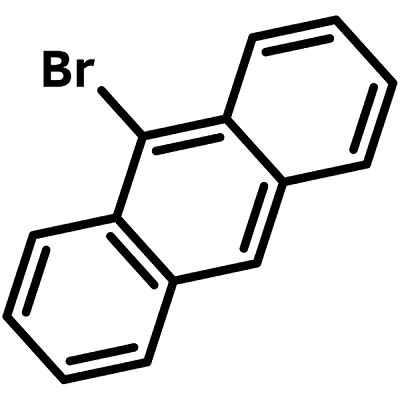9-Bromoanthracene
CAS Number 1564-64-3
Chemistry Building Blocks, Materials, Monomers, Non-Heterocyclic Building Blocks9-Bromoanthracene, a key intermediate
Used for the synthesis of polycyclic aromatic hydrocarbons (PAH) in application of OLEDs.
Specifications | MSDS | Literature and Reviews
9-Bromoanthracene (CAS number 1564-64-3) is a mono-brominated anthracene at 9-position. It is one of the key intermediates for the construction of polycyclic aromatic hydrocarbon (PAH) anthracene. Photodimers of 9-bromoanthracene are suitable alkyl halide initiators in the atom transfer radical polymerization (ATRP) reactions
Non-doped device based on 9-bromoanthracene derived DCPA-TPA provides NIR emission with peaks at 838 nm and a maximum radiance of 20707 mW Sr-1 m-2 was observed for the optimized device based on DCPA-TPA [1]. Also doping device using 3,6-di(anthracen-9-yl)-9-phenyl-9H-carbazole (P-DAC) as the host material showed high luminance efficiencies and external quantum efficiencies of as high as 7.70 cd A-1 and 4.86% with CIE chromaticity coordinates (0.156, 0.136) and 100 mA cm-2 [2].
General Information
| CAS Number | 1564-64-3 |
| Chemical Formula | C14H9Br |
| Full Name | 9-Bromoanthracene |
| Molecular Weight | 257.13 g/mol |
| Synonyms | Anthracene, 9-bromo- |
| Classification / Family | Anthracenes, Semiconductor synthesis intermediates, Low band gap polymers, OLED, OFETs, organic photovoltaics |
Chemical Structure

Product Details
| Purity | >98% (1H NMR) |
| Melting Point | Tm = 105 °C |
| Appearance | Yellow to orange powder/crystals |
MSDS Documentation
Literature and Reviews
- Near-Infrared Electroluminescence beyond 800 nm with High Efficiency and Radiance from Anthracene Cored Emitters, Y. Yu et al., Angew. Chem. Intl. Ed., 59 (48), 21578-21584 (2020); DOI: 10.1002/anie.202006197.
- Highly efficient deep-blue emitting organic light emitting diode based on the multifunctional fluorescent molecule comprising covalently bonded carbazole and anthracene moieties, S. Kim et al., J. Mater. Chem., 21, 9139-9148 (2011); DOI: 10.1039/C1JM11111F.
- Characterization and properties of a novel energetic Co-crystal formed between 2,4,6-Trinitrophenol and 9-Bromoanthracene, S. Bozkuş et al., J. Mol. Struct., 1192, 145-153 (2019); DOI: 10.1016/j.molstruc.2019.04.109.

 9-Bromoanthracene MSDS Sheet
9-Bromoanthracene MSDS Sheet